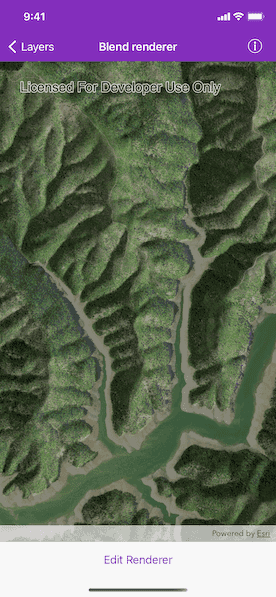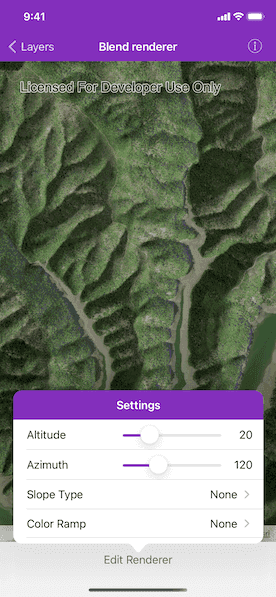Blend a hillshade with a raster by specifying the elevation data. The resulting raster looks similar to the original raster, but with some terrain shading, giving it a textured look.



Use case
Blend renderer can be used to apply a color ramp to a hillshade to emphasize areas of high or low elevation. A Blend renderer can also be used to add a hillshade effect to aerial or satellite imagery, thereby making changes in elevation more visible.
How to use the sample
Tap the bottom button to choose and adjust the altitude, azimuth, slope type and color ramp type settings to update the image.
How it works
- Create an
AGSRasterobject from a raster file. - Create an
AGSRasterLayerobject from the raster. - Create an
AGSBasemapobject from the raster layer and set it to the map. - Create another
AGSRasterobject for elevation from a grayscale raster file. - Create an
AGSBlendRendererobject, specifying the elevation raster, color ramp, and other properties.- If you specify a non-nil color ramp, use the elevation raster as the base raster in addition to the elevation raster parameter. That way, the color ramp is used instead of the satellite imagery.
- Set the blend renderer to the raster layer.
Relevant API
- AGSBlendRenderer
- AGSColorRamp
- AGSRaster
- AGSRasterLayer
Offline data
This sample uses the Shasta.tif and Shasta_Elevation.tif resources. They are downloaded from ArcGIS Online automatically.
Tags
color ramp, elevation, hillshade, image, raster, raster layer, visualization
Sample Code
//
// Copyright 2016 Esri.
//
// Licensed under the Apache License, Version 2.0 (the "License");
// you may not use this file except in compliance with the License.
// You may obtain a copy of the License at
//
// http://www.apache.org/licenses/LICENSE-2.0
//
// Unless required by applicable law or agreed to in writing, software
// distributed under the License is distributed on an "AS IS" BASIS,
// WITHOUT WARRANTIES OR CONDITIONS OF ANY KIND, either express or implied.
// See the License for the specific language governing permissions and
// limitations under the License.
import UIKit
import ArcGIS
protocol BlendRendererSettingsViewControllerDelegate: AnyObject {
func blendRendererSettingsViewController(_ blendRendererSettingsViewController: BlendRendererSettingsViewController, selectedAltitude altitude: Double, azimuth: Double, slopeType: AGSSlopeType, colorRampType: AGSPresetColorRampType)
}
class BlendRendererSettingsViewController: UITableViewController {
@IBOutlet private weak var altitudeSlider: UISlider?
@IBOutlet private weak var altitudeLabel: UILabel?
@IBOutlet private weak var azimuthSlider: UISlider?
@IBOutlet private weak var azimuthLabel: UILabel?
@IBOutlet private weak var slopeTypeCell: UITableViewCell?
@IBOutlet private weak var colorRampTypeCell: UITableViewCell?
weak var delegate: BlendRendererSettingsViewControllerDelegate?
private let numberFormatter = NumberFormatter()
var azimuth: Double = 0 {
didSet {
updateAzimuthControls()
}
}
private func updateAzimuthControls() {
azimuthSlider?.value = Float(azimuth)
azimuthLabel?.text = numberFormatter.string(from: azimuth as NSNumber)
}
var altitude: Double = 0 {
didSet {
updateAltitudeControls()
}
}
private func updateAltitudeControls() {
altitudeSlider?.value = Float(altitude)
altitudeLabel?.text = numberFormatter.string(from: altitude as NSNumber)
}
private let slopeTypeLabels = ["None", "Degree", "Percent Rise", "Scaled"]
var slopeType: AGSSlopeType = .none {
didSet {
guard slopeType != oldValue else {
return
}
updateSlopeTypeControls()
}
}
private func updateSlopeTypeControls() {
slopeTypeCell?.detailTextLabel?.text = slopeTypeLabels[slopeType.rawValue + 1]
}
private let colorRampLabels = ["None", "Elevation", "DEMScreen", "DEMLight"]
var colorRampType: AGSPresetColorRampType = .none {
didSet {
guard colorRampType != oldValue else {
return
}
updateColorRampTypeControls()
}
}
private func updateColorRampTypeControls() {
colorRampTypeCell?.detailTextLabel?.text = colorRampLabels[colorRampType.rawValue + 1]
}
override func viewDidLoad() {
super.viewDidLoad()
updateAltitudeControls()
updateAzimuthControls()
updateSlopeTypeControls()
updateColorRampTypeControls()
}
// MARK: - Actions
@IBAction func azimuthSliderValueChanged(_ slider: UISlider) {
azimuth = Double(slider.value)
blendRendererParametersChanged()
}
@IBAction func altitudeSliderValueChanged(_ slider: UISlider) {
altitude = Double(slider.value)
blendRendererParametersChanged()
}
private func blendRendererParametersChanged() {
delegate?.blendRendererSettingsViewController(self, selectedAltitude: altitude, azimuth: azimuth, slopeType: slopeType, colorRampType: colorRampType)
}
// UITableViewDelegate
override func tableView(_ tableView: UITableView, didSelectRowAt indexPath: IndexPath) {
let cell = tableView.cellForRow(at: indexPath)
if cell == slopeTypeCell {
let optionsViewController = OptionsTableViewController(labels: slopeTypeLabels, selectedIndex: slopeType.rawValue + 1) { (newIndex) in
self.slopeType = AGSSlopeType(rawValue: newIndex - 1)!
self.blendRendererParametersChanged()
}
optionsViewController.title = "Slope Type"
show(optionsViewController, sender: self)
} else if cell == colorRampTypeCell {
let optionsViewController = OptionsTableViewController(labels: colorRampLabels, selectedIndex: colorRampType.rawValue + 1) { (newIndex) in
self.colorRampType = AGSPresetColorRampType(rawValue: newIndex - 1)!
self.blendRendererParametersChanged()
}
optionsViewController.title = "Color Ramp Type"
show(optionsViewController, sender: self)
}
}
}